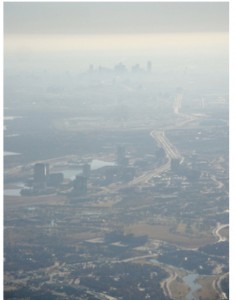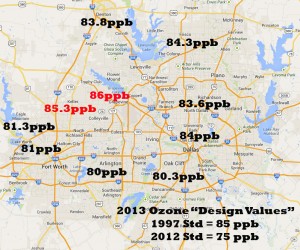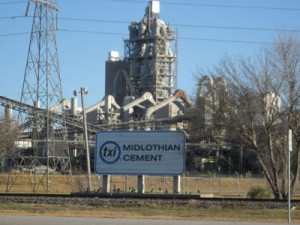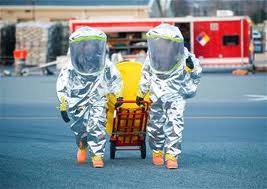EPA
A Barnett Shale Manifesto…From Austin
 Sometimes it takes a perspective above the grind of trench warfare to give you a better sense of what the entire battlefield looks like. That's what UT Law Professor Rachel Rawlins has done for Barnett Shale activists with the recent publication of her article "Planning for Fracking on the Barnett Shale: Urban Air Pollution, Improving Health Based Regulation, and the Role of Local Governments" in the new Virginia Environmental Law Review.
Sometimes it takes a perspective above the grind of trench warfare to give you a better sense of what the entire battlefield looks like. That's what UT Law Professor Rachel Rawlins has done for Barnett Shale activists with the recent publication of her article "Planning for Fracking on the Barnett Shale: Urban Air Pollution, Improving Health Based Regulation, and the Role of Local Governments" in the new Virginia Environmental Law Review.
Don't let the academic title fool you. This is a call for a radically new approach to how communities in Texas regulate the risks of fracking, and every other type of heavy industry. We put the link up for the piece on our Facebook page on Saturday based on a quick reading of its commentary on the Flower Mound cancer cluster, but it's more, so much more than that. Among other things, it's a comprehensive rebuttal of every claim of safety and well-being ever issued by the industry or state authorities about the health of residents living in the Barnett Shale, of which the Flower Mound case is only one example. Rawlins has produced a one-stop catalog of each major air pollution health controversy in the Barnett since concerns began to grow in the last decade, with an almost 30-page review of why no industry or government-sponsored study of fracking pollution and its health effects is a satisfactory response to those concerns. Want to convince your local officials that fracking isn't as safe as it's touted? Here's the staggering blow-by-blow commentary to do it.
But all of that documentation is presented in service to making the point that current state and federal regulation of fracking is failing to protect public health, both in design and in practice. Professor Rawlins' solution to this problem is not to give the state and federal government more power to regulate the gas industry. No, it's to turn the current regulatory framework upside down and give more power to local governments to do the things that the state and federal government should be doing.
In making this recommendation, she echoes the strategy that's been driving Downwinders since it was founded – that the best way to regulate pollution problems is at the local level where the most harm is being done, and it should be directed by the people being harmed. This is what drove our Green Cement campaign that closed the last obsolete wet cement kiln in Texas. This is what fueled our campaign to close down the trailer park-come-lead smelter in Frisco. And it's what was behind the recent Dallas fights over drilling. In each case, it wasn't Austin or Washington DC that was the instrument of change – it was local governments, pressed by their constituents, flexing their regulatory powers. The same thing is driving activists in Denton who are organizing the ban fracking petition drive and vote.
This strategy avoids battles where industry is strongest – in the halls of the state capitol and in DC, where citizens are outspent millions to one. Instead, it takes the fight to neighborhoods where the harm is being done or proposed, where people have the most to lose, where the heat that can be applied to elected officials is more intense. Citizens will still get outspent, but the money doesn't seem to buy corporations as much influence among those actually breathing the fumes of the drilling site, or smokestack.
Particularly now, with corporate-friendly faux-Tea Party types in control of state government and the House of Representatives in DC, there is little room for grassroots campaigns to make a difference by passing new legislation. Even if by some miracle a few bills did pass, their enforcement would be up to the same state or federal agencies that are currently failing citizens. Local is more direct, and more accountable. Professor Rawlins agrees, and spends most of the rest of her 81-page journal article citing the ways in which local control of fracking in the Barnett Shale is hampered by the out-dated top-down approach to regulation, and what should be done to fix that.
Included in her recommendations are two long-term Downwinders projects: Allowing local governments to close the "off-sets" loophole for the gas industry that exempts them from having to compensate for their smog-forming pollution in already smoggy areas like DFW, and creating California-like local air pollution control districts that could set their own health based exposure standards and pollution control measures without having to go through Austin or DC.
If there's a single major fault in Rawlins's analysis, it's that she believes more local control of pollution risks is itself dependent on action by an unwilling state government. But Downwinders and others have shown that isn't true. Our most significant and far-reaching victories – from the closing of the Midlothian wet kilns to the new Dallas drilling ordinance – have all taken place while Rick Perry was Governor and the state legislature was in the hands of our opponents. We did these things despite Austin, not because we had its permission. Local zoning laws, local permitting rules, local nuisance acts, and other local powers are under-utilized by both residents and their elected officials when it comes to pollution hazards.
The same is true now of Downwinders' off-sets campaign aimed at the gas industry. We think we've found a way to avoid the "preemption" argument that would keep local governments from acting on smog pollution from gas sources by aiming the off-sets at Greenhouse gases – an area of regulation Texas is loathe to enter. By targeting GHG reduction, we also reduce a lot of toxic and smog-forming air pollution. It's a back door way, but it accomplishes the same goal. It's going to be up to Texas activists to sew similar small threads of change through an otherwise hostile political environment.
Even given that flaw, Professor Rawlins' introduction to her article is the most concise summary of the air pollution problems caused by gas mining and production in the Barnett, as well as the most credible call to action for a new way of doing business there. Here it is reprinted in full for your consideration:
In the last decade hydraulic fracturing for natural gas has exploded on the Barnett Shale in Texas. The region is now home to the most intensive hydraulic fracking and gas production activities ever undertaken in densely urbanized areas. Faced with minimal state and federal regulation, Texas cities are on the front line in the effort to figure out how best to balance industry, land use, and environmental concerns. Local governments in Texas, however, do not currently have the regulatory authority, capacity, or the information required to closet he regulatory gap. Using the community experience on the Barnett Shale as a case study, this article focuses on the legal and regulatory framework governing air emissions and proposes changes to the current regulatory structure.
Under both the state and federal programs, the regulation of hazardous air emissions from gas operations is based largely on questions of cost and available technology. There is no comprehensive cumulative risk assessment to consider the potential impact to public health in urban areas. Drilling operations are being conducted in residential areas. Residents living in close proximity to gas operations on the Barnett Shale have voiced serious concerns for their health, which have yet to be comprehensively evaluated. Given the complexityof the science, and the dearth of clear, transparent, and enforceable standards, inadequate studies and limited statistical analysis have been allowed to provide potentially false assurances. The politically expedient bottom line dominates with little attention paid to the quality of the science or the adequacy of the standards.
Determining and applying comprehensive health-based standards for hazardous air pollutants has been largely abandoned at the federal level given uncertainties in the science, difficulties of determining and
measuring “safe” levels of toxic pollutants, and the potential for economic disruption. Neither the state nor the federal government has set enforceable ambient standards for hazardous air pollutants.Identifying cumulative air pollution problems that may occur in urban areas, the State of California has called upon local governments to identify “hot spots” and to consider air quality issues in their planning and zoning actions. In Texas, however, preemption discussions dominate the analysis. Any local government regulation that might provide protection from toxic air emissions otherwise regulated by the State must be justified by some other public purpose.
Texas should consider authorizing and encouraging local level air quality planning for industrial activities, similar to what California has done. Care should be taken to separate these facilities from sensitive receptors and “hot spots” that may already be burdened with excessive hazardous air emissions. Given the difficulty of the task, there is also an important role for the state and federal governments in working to establish ambient standards for hazardous air pollutants, as well as standards for health based assessment and public communication. The uncertainty inherent in any of these standards should be made clear and accessible to local governments so that it may be considered in making appropriate and protective land use decisions. Texas should consider allowing local governments to have the power to establish ambient air quality standards, emissions limitations, monitoring, reporting, and offsets for hazardous air pollutants, following the model applied to conventional air pollutants pursuant to the federal program.
Professor Rawlins' article provides Barnett Shale activists with a new map to guide them toward more effective action. We'd all do well to study it and pick local battles that promise to contribute toward its realization.
Between Now and Friday: Tell Them What They Can Do With Their Smog
 Frustrated that Rick Perry's Texas Commission on Environmental Quality isn't doing enough to end DFW's chronic smog problem, the local "Council Of Governments" has issued a "Request for Information" asking for the public's help in suggesting ways to reduce ozone pollution in North Texas.
Frustrated that Rick Perry's Texas Commission on Environmental Quality isn't doing enough to end DFW's chronic smog problem, the local "Council Of Governments" has issued a "Request for Information" asking for the public's help in suggesting ways to reduce ozone pollution in North Texas.
Please use our Click N' Send E-mail form to make sure they get the message that the public wants:
1) State-of-the-Art pollution controls on huge "point sources" of pollution like the Midlothian cement kilns and East Texas power plants.
2) New pollution control equipment and strategies to reduce the air pollution from the thousands of natural gas facilities mining the Barnett Shale.
3) Inclusion of all trucks and off-road vehicles in the state's vehicle maintenance and inspection program.
You can also add strategies or ideas of your own as well. Just click here, fill out the e-mail and send it in to be counted.
It takes as little as 30 seconds.
BUT YOU ONLY HAVE UNTIL 5 pm FRIDAY, VALENTINE'S DAY.
______________________________________________________________
Rick Perry's TCEQ is so discredited on the matter of DFW smog, local officials usually working in concert with the state agency are now looking elsewhere for help.
Ever since DFW was required to write and submit new clean air plans, The North Central Texas Council of Governments has been the local vehicle used by the state to funnel information, concern, and ideas back and forth.
It was never easy to get Austin's attention or convince the Powers That Be of the need to take bigger clean air measures. It took a decade for Downwinders to get the State to admit that the Midlothian cement plants had a huge impact on local air quality before they were the targets of new controls.
But ever since Rick Perry began running for President in 2010, it's been impossible for Austin toget serious about any DFW clean air plan. For the past four years, TCEQ has claimed that it can reduce air pollution enough by doing nothing.
That strategy has been a dismal failure. New car buying in the middle of the worst economic downturn since the 1930's was the TCEQ clean air plan in 2011. Austin promised that if we just sat back, we'd have the lowest smog levels ever recorded. Instead we had worse air pollution levels than we did five years ago.
This time round, TCEQ is saying a new EPA-mandated low-sulfur gasoline mix in 2017 will be the region's savior for the new clean air plan that's supposed to be successful in reaching the new federal ozone standard of 75 parts per billion in 2018. We're at 87 ppm now – still in violation of the old 1997 standard.
Just watch this new fuel being added to cars and see the ozone numbers drop, TCEQ is saying. No need to put controls on gas facilities, or cement kilns, or power plants. Nothing that would give Rick Perry's opponents on the Right any opportunity to claim he was "anti-bidness."
Even the Council of Governments isn't buying it.
That's why, in their own bureaucratic fashion, this Request for Information that the COG has issued is it's own middle-of-the-road middle finger to TCEQ.
Usually, it would be the state facilitating a discussion of new air pollution control strategies, but since it's obviously not interested, the COG has decided to go its own way. That's how bad things have gotten in Austin – even their most reliable allies in DFW can no longer take them seriously.
It's not clear what will happen to the list of control measures that the Council of Governments is assembling. Some might receive some more official attention, but locals have no authority to write or override Austin's decisions. TCEQ is the only entity that's authorized to submit a new clean air plan to EPA by the June 2015 deadline.
But there are ways to use the useless clean air plans that Austin is submitting. Downwinders' own green cement campaign is a great example.
In 2007, we successfully inserted a voluntary air pollution control strategy into the TCEQ plan revolving around the purchasing of cement from newer cleaner "dry" kilns by local North Texas governments. We then took that "green cement" procurement option and went to Dallas to pass the nation's first green cement ordinance. Then Fort Worth passed it. Then Plano. Then Arlington. Then Denton. Then Dallas County. Then Tarrant County.
Within two years, we had established a de facto moratorium on dirtier "wet kiln" cement within at least a dozen municipal and counties. Combined with federal rule changes, we were able to get all Midlothian wet kilns closed. The last one is being be converted to a dry kiln this year. All while Rick Perry was governor.
The same thing could happen with a good "off-sets" policy for gas facilities if a local city of county could pass a template ordinance showing the way. Currently, most of the gas industry is exempt from being required to "off-set" their air pollution in smoggy "non-attainment" areas like other large industries in DFW. Take away this exemption and you'll see a swift decrease in gas industry air pollution.
It's these kinds of strategies that don't depend on action from Austin that offer the greatest potential for progress this time around.
TCEQ has never written a successful clean air plan for North Texas, and it's not going to start now. But citizens themselves can take their lungs' fate into their own hands and begin to build a system of local measures that can make breathing easier.
______________________________________________________________
CALENDAR AND STATUS REPORT OF DFW'S NEWEST CLEAN AIR PLAN
Reach a 3-year rolling average of no more than 75 ppm of ozone at all 18 DFW area air monitors.
Can You Hear Me Now? EPA’s National “Listening Session” on New Coal Carbon Pollution Rules This Thursday
 Many of you have already seen the increasingly urgent pleas from the usual suspects for people to show up at this Thursday's national EPA "Listening Session" on new emission standards for Greenhouse Gas pollution. Try to ignore the New Age-by-way-of-George-Orwell alternative name for a public hearing, and the industry-friendly "listening" schedule of 10 am to 3 pm, and concentrate on the fact this is one of only a handful of such sessions taking place nationwide, and it's in Texas, our Texas.
Many of you have already seen the increasingly urgent pleas from the usual suspects for people to show up at this Thursday's national EPA "Listening Session" on new emission standards for Greenhouse Gas pollution. Try to ignore the New Age-by-way-of-George-Orwell alternative name for a public hearing, and the industry-friendly "listening" schedule of 10 am to 3 pm, and concentrate on the fact this is one of only a handful of such sessions taking place nationwide, and it's in Texas, our Texas.
Like it or not, public health-minded residents of DFW have the burden of showing up to national hearings like this just to prove we exist. Nobody expects there to be an viable environmental movement in the Belly of the Beast, especially outside Austin. However hard we work to change that image, it's still a popular one and in this case, it hits entirely too close to home. Because Texas is the world capitol for carbon pollution. We're Numero Uno, A Number 1. We're living in the barrel of the gun that's pointed right at the planet's head.
EPA recently reported that Texas released more GHG pollution in 2012 than the next two states – Indiana and Pennsylvania – combined. We're responsible for a full 12.5 % of the entire US annual total, almost 400 million metric tons of the stuff, ever year. Just take a look at the difference between us and the other 49.
Then use this handy-dandy EPA map of incredibly large sources of GHG pollution in the US. It allows you to zoom down to what's in each county of each state. Look at all the sources around DFW. Most are also large sources of other kinds of pollution. We're living in a sea of pollution created by these facilities.
So when EPA decides to schedule its one and only listening session in Texas on new rules to reduce this kind of pollution from some of the biggest sources in our own backyard, we need to show up because we're a disproportionate part of the problem.
We also need to be there because industry will be there, in force. The old TXU really wants to keep its obsolete, lignite-burning East and Central Texas coal plants running without any of these modern pollution control contraptions. Doesn't matter if they're aimed at Particulate Matter, or smog-forming pollution or GHGs, they just don't want them. You can bet they'll be bringing in folks from those coal plants to say what a terrible economic cost it would impose on the host communities and the company, and how it'll put the entire statewide grid in peril.
Someone has to be there to balance that testimony by pointing out that the economic, public health, and environmental impacts of this pollution reach far beyond Limestone County, Texas or even the US, and need to be considered on the agency's balance sheet as well.
Every yahoo with Americans for Prosperity, or other industry astroturf groups will be there because these kinds of national forums to bash Obama's energy policies are what they live for – and it's the only thin they do halfway competently. Likewise for the industry-aligned Freedom Works branch of the Tea Party.
And does someone want to start an office pool on how many Republican primary candidates will be appearing, trying to outflank each other on their Right? Expect to see and hear a lot about "Obama's War Against Coal" on Thursday. It's Texas.
Which is why even if you're not a fan of this Administration, you have to recognize that the first attempt to regulate greenhouse gases from coal plants should be encouraged, in Texas. It's a foot in the door to do more effective things, to start talking about GHG regulations in a serious way. It establishes a precedent. And that is what industry fears the most. You don't have to like the EPA to understand that the enemy of your enemy is your friend in this fight. And did we mention it's in Texas?
Finally, we just emerged from an ozone season that was mild by recent standards – but still harsh enough to keep us in violation of the old 1997 smog standard. We know the East and Central Texas power plants contribute to DFW's air quality problems. These new carbon regulations EPA is considering for existing power plants have the potential to reduce a variety of air pollution, not just GHGs. We know Austin and TCEQ are going to be of no help in addressing these sources in the next DFW clean air plan. If reductions are going to happen, they're going to have to be driven by the EPA, local governments, or the marketplace. We can't let this opportunity for meaningful reductions and better air pass us by. If for no other reason, you need to show up on Thursday and say you support the EPA's regulation of these facilities because you've given up on Texas doing so.
For lots of reason, it's in your own self interest to attend this thing, even if you real passion is gas field pollution, or smog, or cement plants or whatever. A victory in this category of regulation is a victory for all of us involved in clean air issues. And it's Texas.
National EPA "listening session" on carbon limits for existing coal plants
THIS Thursday, November 7, 10:00 a.m. to 3:00 p.m.
1st Floor Auditorium, J. Erik Jonsson Dallas Central Library, 1515 Young Street, Dallas, TX (map)
2013 DFW Smog Report: Failure….Again
 (Dallas)— On the eve of constructing yet another DFW clean air plan, the 2013 Ozone Season ended on Thursday the same way the previous 16 have ended: with North Texas out of compliance with the 1997 federal clean air standard.
(Dallas)— On the eve of constructing yet another DFW clean air plan, the 2013 Ozone Season ended on Thursday the same way the previous 16 have ended: with North Texas out of compliance with the 1997 federal clean air standard.
Even a mild summer with lower temperatures and more rain couldn't save the numbers from exceeding an illegal three-year running average of 85 parts per billion at monitors in Keller and Grapevine.
According to Jim Schermbeck with the clean air group Downwinders at Risk, what makes this year’s violation particularly troublesome is that the 1997 standard has been replaced with a more protective one that's 10 ppb lower. “For the next DFW air plan to succeed, it will have to reduce smog to levels that no DFW monitors have ever recorded. I don’t know anyone outside of Austin who thinks the state is up to that task.”
That new plan has its official kick-off event next Tuesday, November 5th, beginning at 9am in Arlington at the Council of Governments Headquarters. It's the first briefing from the Texas Commission on Environmental Quality on the computer model it will be using to base the plan on. Everything about one of these plans is based on such a computer model, a model only the state can run. The plan must be submitted to EPA by June of 2015.
Even though extremely high ozone numbers were rarer this year, there were enough bad air days to cause the running averages of 10 out of 17 monitors, called "design values" to rise – not the kind of trend you want when you're next task is complying with a tougher standard.
Schermbeck was particularly concerned about a monitor near Mockingbird and I-35 in Central Dallas that’s seen its ozone average rise dramatically for three years in a row. “This is a monitor that had a "design value" of 67 parts per billion in 2010 – that is, it was in compliance with the new 75 ppb standard just three years ago. But now it’s up to 84 ppb and almost out of compliance with the 1997 standard. That's quite an increase in three years, and in a place where smog hasn’t been a problem for awhile.”
Every monitor inside the DFW metro area and even most "rural" monitors had a design value above the new standard of 75 ppb. Only Kaufman and Greenville made it under the wire, barely, with readings of 74 ppb.
As usual, the worst ozone levels were found in the northwest quadrant of the DFW area. This is a well-known historical pattern caused by the predominant southeast to northwest winds that blow pollution from the coast up through the coal and gas patches of East and Central Texas, over the Midlothian Industrial Complex and North Texas central urban cores into Northwest Tarrant Wise and Denton counties
This pattern has been the target of the last three state clean air plans, but has never been overcome. Schermbeck noted that last clean air plan to make a dent was the 2006 effort that produced lower numbers in steady fashion. Since 2008 however, air quality that was supposed to be getting better has gotten worse, or stagnated.
While cars have gotten cleaner during this time, and pollution from cement and coal plants has been reduced, there's one "source category" of pollution that's increased significantly since 2008: the gas industry.
In submitting the last DFW air plan to EPA in 2011, the Texas Commission on Environmental Quality estimated there were more tons of smog-forming Volatile Organic Compounds being released by the gas industry in the official DFW "non-attainment area" than by all the cars and trucks on the road combined. That wasn't true in 2008.
Moreover, this is new air pollution in a smog non-attainment area that doesn't have to be off-set by reductions in pollution elsewhere in DFW. Unlike every other large industry, the gas industry is exempt from this offset requirement of the Clean Air Act.
Denton's Airport monitor's 4th highest reading of 85 ppb this summer, the one that officially counts toward its running average, was the highest such reading in the entire state, including Houston.
There's no doubt Denton is in the middle of the local gas patch, as are the Keller and Grapevine monitors that had the highest design values this year. Given the decreases in pollution from other categories, are gas patch emissions keeping these numbers from coming down they way they were supposed to? Austin keeps saying no, but the evidence is compelling.
Just last year there was a study out of Houston showing how a single flare or compressor station could significantly impact local ozone levels by as much as 5 or 10 ppbs. TCEQ itself just produced a study this last summer showing how Eagle Ford Shale gas pollution is increasing ozone levels in San Antonio.
Local Barnett Shale gas pollution might explain these Tarrant and Denton county monitors' problems, but they don't explain the rise in numbers of the Dallas monitors, since the wind during ozone season comes in from the south to southeast.
What new pollution is coming from that direction? Gas industry pollution from numerous compressor stations and processing plants stations in Freestone, Anderson, Limestone and other counties just about 90 to 100 miles south-southeast of Dallas. If one adds up all the emissions these facilities are allowed under their "standard permits." it exceeds the pollution from coal plants like Big Brown. That's a huge hit from sources that weren't there 10 years ago.
In effect, DFW is getting squeezed between gas pollution being produced in the middle of its urban areas, and gas pollution blowing in from the south.
“Officials with Rick Perry's TCEQ would rather drink lye than admit gas pollution is causing smog problems for DFW” says Schermbeck, “but such an admission might be the only way to bring DFW into compliance with the Clean Air Act.”
“This is why local DFW municipal and county governments serious about air quality must divorce themselves from Austin's politicized science and begin to seek their own solutions. Austin really isn't interested in solving DFWs chronic smog problems. Heck, the Commissioners who run TCEQ don't even believe smog IS a health problem.”
Downwinders Had A Good Day in Court Battling EPA Over Cement Plant Rules
 Downwinders has been trying to get new emission limits for cement plants since the mid-1990's. We're still trying.
Downwinders has been trying to get new emission limits for cement plants since the mid-1990's. We're still trying.
The first real reform in those rules during the Clinton Administration were pathetically inadequate. Downwinders and other groups assisted by DC-based Earth Justice sued to get them strengthened. We won. When new rules finally emerged from EPA in 2009, they were much better. Many of you came out to the historic national hearing at the DFW Airport hotel to testify in favor of them.
These rules were on their way to being signed by President Obama when they got hijacked by industry at their stop at the Office of Management and Budget, which must review all new regulations. When they emerged, they were unrecognizable in many ways, with deadlines pushed back by years and the important Particulate Matter standard being significantly weakened.
Once again, we're back in court trying to get these watered down rules thrown out. Last week, the DC appeals court that usually takes up federal regulatory fights heard oral arguments from both sides, and even the Republican judges on the panel were skeptical of the Administration's rewrite job.
Reprinted in full below is an inside-the-Beltway account of the proceedings that gives you some idea of what's at stake and what a good day citizens and their representatives enjoyed in court. No date on when to expect a ruling. Even then, if we win, the rules go back to EPA to be rewritten again, albeit with more judicial constraint…theoretically at least.
Judges seem skeptical of EPA claims in cement emissions case
Jeremy P. Jacobs, E&E reporter
Published: Thursday, October 24, 2013
Public health advocates argued in court today that U.S. EPA unlawfully weakened and delayed air standards for cement manufacturers, appearing to gain some traction with a panel of federal appellate judges.
The Natural Resources Defense Council contends EPA caved to industry pressure when it revised its National Emission Standards for Hazardous Air Pollutants, or NESHAP, for portland cement kilns and pushed back its compliance date by two years.
EPA's standards apply to several pollutants, including particulate matter, mercury and other acid gases. The agency revised the particulate matter standard after a court ruling in 2011, but advocates claim the agency did more than the ruling required.
James Pew of Earthjustice, representing the NRDC, told the U.S. Court of Appeals for the District of Columbia Circuit that EPA "gratuitously weakened the particulate matter standard" and violated the "plain and literal meaning" of the Clean Air Act.
Further, he said, many of the issues EPA addressed with its changes "didn't come up" in the previous case.
The cement NESHAP has long been the subject of controversy and litigation.
The kilns are one of the top sources of man-made mercury emissions in the United States. Public health advocates forced EPA to set the standards in a 2010 lawsuit, and when the agency issued the standards later that year it said they would prevent 960 to 2,500 deaths per year.
Industry, however, quickly challenged the standards at the D.C. Circuit. In December 2011, the court ordered EPA to reconsider the standards by taking commercial incinerators that burn solid waste out of its calculations. However, the court largely left the standards in place, including their 2013 compliance deadline (E&ENews PM, Dec. 9, 2011).
When EPA recalculated the standard for particulate matter, the advocates claim the agency made it less stringent. Additionally, EPA reached a settlement with the portland cement industry to delay compliance to September 2015 for all pollutants — not just particulate matter (Greenwire, Dec. 7, 2012).
Public health advocates challenged both actions, as well as a shift from continuous monitoring to one-time annual stack testing for compliance — which also changed the particulate matter standard. The environmentalists also question the standard's inclusion of an "affirmative defense" that protects kilns from citizen lawsuits if they violate the standards during an unavoidable malfunction.
Each issue came up today before a three-judge panel, which included two judges who are considered potential future Supreme Court nominees. The panel appeared receptive to some of the advocates' arguments but not to others.
For example, Judge Brett Kavanaugh, one of the country's leading conservative jurists, appeared skeptical of EPA's decision to delay standards for mercury and other gases to 2015, even though the Clean Air Act says standards must take effect within three years. The 2010 standards for those pollutants, which weren't affected by the D.C. Circuit ruling in 2011, should be in effect now.
"I don't understand," said Kavanaugh, a Republican appointee. "I need help. I don't understand the interrelatedness."
Further, Senior Judge Harry Edwards, a Democratic appointee, said EPA could have easily linked the standards by saying it wasn't "practicable" to meet some without meeting the others. But EPA, Edwards said, never made that argument in the rulemaking.
"I'm really not following this," Edwards said. "Where does the agency make the finding … that compliance couldn't be done practicably?"
Matthew Oakes of the Department of Justice, representing EPA, countered that all the standards are related because the pollution control technology required to limit particulate matter also controls emissions of mercury and other gases. Therefore, it didn't make sense to require kilns to install technology for mercury, for example, before it knew the final particulate matter standard, he said.
That argument was echoed by Carter Phillips of Sidley Austin LLP, representing the cement industry, which intervened in the case.
"You cannot implement any of them in a one-off system," he said.
It was unclear which way the judges were leaning with regard to the advocates' arguments surrounding the particulate matter standard itself. But they appeared receptive to their challenge to EPA's affirmative defense.
Oakes argued that the advocates lacked standing to challenge the affirmative defense, meaning they had failed to prove how they would be injured by it. That notion was flatly rejected by the panel, which said the defense would allow kilns to, at times, exceed the standards, which would harm human health. Therefore, the advocates have grounds to bring the lawsuit, the judges said.
The panel was also skeptical of EPA's arguments on the substantive issue of whether EPA could create the affirmative defense in the first place. Judge Srikanth Srinivasan, President Obama's first appointee to the D.C. Circuit and a leading liberal judge, contended that the Clean Air Act didn't grant EPA that ability.
"This authority wasn't delegated to the EPA to begin with," he said.
EPA will Be Issuing Power Plant Permits in Texas Despite Greg Abbott’s Campaign for Governor
 There was never really any question, but just in case you were wondering, EPA will indeed be taking over the permitting of power plants in Texas based on new greenhouse gas emission rules.
There was never really any question, but just in case you were wondering, EPA will indeed be taking over the permitting of power plants in Texas based on new greenhouse gas emission rules.
The U.S. Court of Appeals slapped down Texas Attorney General Greg Abbott's recent challenge to the Environmental Protection Agency on Friday, one trying to keep the EPA from considering such emissions when they permit new facilities or approve large modifications on old ones.
Another Study Reveals Why Our System of “Safe Levels” is a Tragic Mirage
 Gas well, cement plant, lead smelter, plastics plant, refinery, compressor, incinerator. Anyone who's ever lived next door to an industrial polluter knows there's the way the facility appears to be operating on paper and how it's actually operating in the real world.
Gas well, cement plant, lead smelter, plastics plant, refinery, compressor, incinerator. Anyone who's ever lived next door to an industrial polluter knows there's the way the facility appears to be operating on paper and how it's actually operating in the real world.
The way it's operating on paper is completely portable. You can take this version of the facility anywhere. The numbers and printouts and charts can show up to congressional hearings. They can be included in PowerPoint presentations, along with glossy pics of the place itself. They can be summarized. They have no smell. They have no texture. They don't make a sound. On paper, expressed in language and figures, the facility may seem to be operating properly under every permitted limit it has to abide by.
On the ground however, it may be a completely different story. It may mean strange petrochemical or plastic smells wafting through your house in the middle of the night. It could mean a series of loud explosions or pops that nobody has ever been able to explain to you. It could mean rashes on your skin, or headaches, or nausea, or asthma attacks. It could mean living in fear of chemical assault. All the time.
This version of operations is not portable. One can write about it or talk about it, but that will not put other people there. And indeed, descriptions of these circumstances can sound so nightmarish that listeners assume you're exaggerating. You're not. Not even video or film can immerse you in it. No amount of reporting about it can make you feel in it. The map is not the place. The only way to know this side of operations is to live it. Day in, day out.
The difference between what the paper version of polluting says, and what the people living it know, is a front line of social justice in the 21st Century.
It also happens to be a major frontline for science, as demonstrated by a recent landmark study from, of all places, Texas Tech about how the sum of pollution is greater than its sometimes desperate parts We're late in covering this, but thanks to the Denton Record Chronicle's for bringing it to our attention back in June. Because this study underscores once again in a big way why our entire system of regulating chemical exposures is so completely contrary to what we know about how those exposures are affecting us.
Tech scientists took two chemicals that are known to cause cancer in large amounts, arsenic and estrogen, and exposed human prostate cells to very low amounts of each. The amounts they exposed the prostate cells to were so low, they fell below the EPA regulatory "safe" level that limits releases of the chemicals from polluters. Individually, the exposures of the cells to arsenic and estrogen were so low as to believed to be harmless. But they weren't.
Instead, the Tech researcher's peer-reviewed, journal-published study found the combination of the low doses of the two chemicals combined was almost twice as likely to create cancer in the prostate cells as the single chemical exposures individually. That is, the toxic interaction or "cumulative effect" of the two chemicals was more than the sum of their parts. There was a "synergestic" reaction inside the cells that the current regulatory system doesn't recognize as even a possibility.
“The majority of cancers are caused by environmental influences,” Singh said. “Only about 5 to 10 percent of cancers are due to genetic predisposition. Science has looked at these chemicals, such as arsenic, and tested them in a lab to find the amounts that may cause cancer. But that’s just a single chemical in a single test. In the real world, we are getting exposed to many chemicals at once.”
Singh became interested in looking at arsenic because water well problems in his native India had recently highlighted mass poisonings from contamination of the chemical. He wondered how this exposure would interact with other carcinogens within the same population.
He focused on estrogen as the second chemical because of the chemical’s ubiquity. Many plastics, such as food can liners, release bisphenol A (BPA), and other chemicals that mimic estrogen in the body.
Unlike more potent chemicals that do major damage to the DNA in a cell, such as benzene, arsenic and estrogen aren’t major mutagens Singh said. Instead, their presence tends to stop certain genes from expressing. The process is called DNA hypermethylation.
…the two chemicals stopped the MLH1 gene, which is responsible for sending the signal to start the self-destruct sequence when a cell is damaged. Because the self-destruct couldn’t activate, the cells became cancerous after exposure.
“With the lower dose not killing the cell, it’s causing damages that go under the cell’s radar. We found when you have two compounds together, lower doses could be more serious problem.”
This is what's called a non-linear impact. You can actually get harmed more by long term low-level exposures than by intense bursts of short term exposure – exactly the opposite of the way the system regulates chemical exposures now.
Currently that system assumes it can protect the public health from exposures to over 80,000 chemicals on the marketplace by regulating the average intake of these chemicals one at a time. It says: "we know that lead and benzene are bad for you if you OD on them, but by only exposing you to a little bit every day, we can keep you from getting damaged by its health effects." The dose is the poison. A little bit cant hurt you, but a lot can kill you.
Unfortunately, this view, which is the foundation for all modern regulatory schemes for chemical pollution, is based on a worldview of human physiology that's now dangerously out of date. For the past 50 years at least, study after study has shown that there are a lot of less-than-drop-dead health effects that couldn't be diagnosed without modern technology. The more we learn about how how bodies work the more we learn new ways about how chemicals can really screw them up. The Tech study is just the latest, albeit dramatic example.
Moreover, of those 80,00 chemicals only about 200 can be said to have been studied even remotely "thoroughly" and fewer that that have been examined for their interactions with any of the other 79,999. So the system itself is a big fat theory in progress, with very little real science supporting it. We're all its Guinea Pigs. It's an hypothesis.
But its a hypothesis with billions invested in it. So to prove it wrong is to threaten a lot of people with a lot of money.
Which is why the chemical industrial-government complex is trying very hard to hold back the tide of this kind of science and what it means. Meanwhile the gap between the paper version of how things are operating at a facility and the real world impact of those operations continue to grow. At some point the contradictions will be too much to ignore or withstand. But we're a long way from that point yet. Which is why we need your help to keep fighting on behalf of those folks living the truth on the ground and prevent more victims of this obsolete and harmful regulatory system.
Will Obama Adminsitration Get Smackdown From Chemical Safety Board?
 The disaster in West, Texas has, at least for the moment, altered the regulatory radar concerning hazardous materials and emergency planning. Trying to take advantage of that fact is The US Chemical Safety Board, an independent agency that seems to be using the incident to press for long sought safety upgrades in several industries.
The disaster in West, Texas has, at least for the moment, altered the regulatory radar concerning hazardous materials and emergency planning. Trying to take advantage of that fact is The US Chemical Safety Board, an independent agency that seems to be using the incident to press for long sought safety upgrades in several industries.
The USCSB investigates industrial accidents and issues recommendations to regulators, such as the Environmental Protection Agency and OSHA, as well as companies, states and local authorities, but it lacks the authority to force regulators or companies to make changes on its own.
On July 25th the Board is due to hold a meeting where it's threatening to label the Administration's inaction on regs for combustible dust as "unacceptable" and raise the stakes by categorizing the regs as "Most Wanted" – the first time that's ever happened in the 30-something history of he board. That might sound like weak tea to you and I but it's pretty strong language coming from this group.
The safety board “has made a number of recommendations to OSHA over the years on life-threatening issues, and OSHA hasn’t really responded through the regulatory process,” Matt Shudtz, a senior policy analyst for the Center for Progressive Reform, said in an interview.
Four of the seven recommendations on next week’s agenda would apply to combustible dust, which caused three major industrial explosions in 2003, killing 14. OSHA has been considering a rule to regulate these facilities since 2009, and hasn’t yet submitted even its initial proposal to the White House for review.
Ammonium nitrate, which fueled the West explosion, is now regulated by local, state and federal agencies in a “patchwork that has many large holes,” board Chairman Rafael Moure-Eraso said at a Senate hearing last month. However, regulating that chemical isn’t on the agenda next week: The investigation into that incident continues, and the board hasn’t made any recommendations to include on a ‘most wanted’ list, according to Hillary Cohen, an spokeswoman for the board.
Grassroots groups should do their own investigations into local emergency planning committees mandated by law and see how well their County is doing. As Channel 8 Bret Shipp found out, Ellis County, home to some of the most toxic industries in North Texas, has fallen down on the job, but it wouldn't surprise us to learn that they're in the majority.
“Scant Oversight and Lax Reporting” Doom Federal Right-to-Know Regs
 Reuters examines the almost 30-year old Emergency Planning and Community Right to Know Act and finds that, depending on what state you live in, the information that's supposed to be provided to the public is either semi-correct, or full of holes you can drive tanker trucks through.
Reuters examines the almost 30-year old Emergency Planning and Community Right to Know Act and finds that, depending on what state you live in, the information that's supposed to be provided to the public is either semi-correct, or full of holes you can drive tanker trucks through.
One of the provisions of the Act is supposed to be an annual inventory of all hazardous chemicals on site at a particular facility. Some 500,000 different substances are covered under the regs and should be accounted for…
But facilities across the country often misidentify these chemicals or their location, and sometimes fail to report the existence of the substances altogether. And except for a handful of states, neither federal nor local authorities are auditing the reports for errors.
As was demonstrated in West, recently, it's important to know what hazardous materials are stored where and in what quantity. Not only for the sake of surrounding residents, but for the first responders coming to their aid in any kind of accident or incident. Reuters cites several examples where firefighters showed-up and were injured on the scene when they didn't know a hazardous chemical was on-site.
A recent Congressional study estimated 60 deaths, more than 1,300 injuries and more than $1.6 billion in onsite and off-site damages caused by accidents at facilities storing 140 Tier II chemicals that have been deemed most dangerous by the EPA.
These numbers also don't include accidents at oil and gas industry sites, often exempt from the same reporting requirements as other industries. It's another reason why Dallas should include a complete, water-proof disclosure provision in any new gas drilling ordinance its Council passes.
What Did Senator Vitter Get for Holding Gina McCarthy Hostage?
 That's the question that Politico poses and, as some of you might already suspect, the answer is: too much.
That's the question that Politico poses and, as some of you might already suspect, the answer is: too much.
